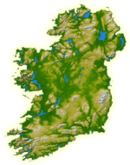Machaire Eabha | |
|---|---|
 Maugherow Peninsula (Red) within County Sligo | |
 | |
| Geography | |
| Location | Ireland |
| Adjacent to | |
| Area | 57.2 km2 (22.1 sq mi) |
| Administration | |
| County | Sligo |
| Demographics | |
| Population | 3,105 (2016 [1] ) |
| Pop. density | 54.3/km2 (140.6/sq mi) |
The Maugherow Peninsula (Irish : Machaire Eabha) [2] is the largest and westernmost peninsula of County Sligo, Ireland. It is also less commonly referred to as the Raghly Peninsula, after Raghly Point (Irish : Gob Reachla), which is itself a headland of the peninsula. The peninsula acts as the northern boundary of Sligo Bay.
Contents
The peninsula's rugged coastline and exposed location has made it far less popular as a tourist destination than some of Sligo's other peninsulas, such as Mullaghmore, Rosses Point and Coolera. The area is largely flat and agricultural in nature, characterised by ribbon development. [3] Carney is the sole nucleated village on the peninsula proper, while the larger town of Grange is located on the margins of the peninsula.





